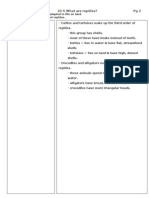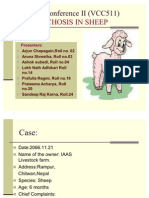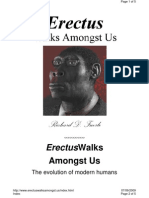Bel Genbio
Bel Genbio
Uploaded by
reneealyssonCopyright:
Available Formats
Bel Genbio
Bel Genbio
Uploaded by
reneealyssonOriginal Description:
Original Title
Copyright
Available Formats
Share this document
Did you find this document useful?
Is this content inappropriate?
Copyright:
Available Formats
Bel Genbio
Bel Genbio
Uploaded by
reneealyssonCopyright:
Available Formats
Balmez, Belinda D.
BS-Pychology 1-1
Learning Activity 9 - The Animal Kingdom
1. Given below are animals representing different phylum. Identify to which phylum they belong and
give their characteristics. Complete Table 9-2.
1. scypha 6. snail
2. corals 7. sea urchin
3. tapeworm 8. grasshopper
4. earthworm 9. ascaris
5. rotifers 10. frog
2. Complete Table 9-2.
REPRESENTATIVE PHYLUM CHARACTERISTICS
ANIMALS
Scypha Porifera Scypha are small, tube shaped
marine calcareous sponges.
They are sedentary and attach
in colonies to rocks and other
non-moving material in a
shallow seawater.
Corals Cnidaria A coral is a tubular sac-like
animal with a central mouth
surrounded by a ring of
tentacles. The end opposite
the tentacles, called the base,
is attached to the substrate.
Tapeworm Flatworm Tapeworms are bilaterally
symmetrical. Some consist of
one long segment; others have a
definite head, followed by a
series of identical segments
called proglottids. The head, or
scolex, bears sucker and often
hooks, which are used for
attachment to the host.
The body covering is a tough
cuticle, through which food is
absorbed.
Earthworm Annelid An earthworm has a
streamlined body with no
antennae or fins or arms or
legs. This streamlined shape is
an adaptation to living in
narrow burrows underground
and the need to move easily
through the soil.
Rotifers Rotifera Rotifers has a ring of hair-like
structures. They are considered
to be the smallest animals on
Earth.
Snail Mollusca It has a lengthy, moist,
unsegmented, squishy, and
slimy body. A hard shell
typically surrounds the body to
protect it. The snail's head,
neck, visceral hump, tail, and
foot are all parts of its body. A
pair of tentacles or feelers are
on the head.
Sea Urchin Echinoderm It is spiny and ovoid-shaped. Its
upper surface is domed and the
underside is flattened. The
mouth has a complex structure
made up of five calcium
carbonate plates.
Grasshopper Arthropod Ringlike segments, jointed
appendages, exoskeleton.
Three body regions, three pair
legs, one pair antennae,
tracheal system, usually two
pair wings.
Ascaris Roundworms They have no distinct head.
Four longitudinal lines are
present in both males and
females – two lateral, one
ventral and one dorsal line.
The mouth is present at the
anterior end and is guarded by
three lips – two sub- ventral
lips and one dorsal lip.
Sensory papillae and amphids
are present on the lips.
Frog Chordata Frogs have protruding eyes, no
tail, and strong, webbed hind
feet that are adapted for
leaping and swimming. They
also possess smooth, moist
skins. Many are
predominantly aquatic, but
some live on land, in
burrows, or in trees.
Analysis
1. In what ways animals are different from one another?
Animals differ from one another according to their appearance, traits, habit. Like all living
things, animals also grow, change, reproduce, and respond to their environment. All
mammals share certain characteristics that make them different than birds or reptiles. They
can be easily differing and identify through their function, character, and classification.
2. How are they classified?
The animals are being classified based on the Linnaeus method, species are arranged and
grouped based on shared characteristics. The levels of classification are kingdom, phylum,
class, order, family, genus, species. The system of classification was based on their
morphology or physical appearances like sharing the same feature or characteristics.
3. Why are animals important for the ecosystem?
Animals are important for the ecosystem as they help plants reproduce by carrying pollen
from plant-to-plant and by spreading seeds. Animals that eat insects and small mammals
help reduce damage by caterpillars, rabbits, and other plant-eaters. Every plant and animal
play a role in the ecosystem. All animals play an important role in maintaining balanced
ecosystems as losing animals may affect or make changes to its surrounding.
You might also like
- Powerpoint Invertebrate AnimalsDocument51 pagesPowerpoint Invertebrate AnimalsSam RogandoNo ratings yet
- Invertebrate Groups Palm CardsDocument2 pagesInvertebrate Groups Palm CardsVAnastarNo ratings yet
- Scan 25-Aug-2020 PDFDocument13 pagesScan 25-Aug-2020 PDFMuskan DffNo ratings yet
- Limulus: Muddy Partly Rawling KingDocument8 pagesLimulus: Muddy Partly Rawling Kingdhaval dongaNo ratings yet
- BIO 102 LECTURE NOTES From DiverifyDocument14 pagesBIO 102 LECTURE NOTES From DiverifynwanicelyneNo ratings yet
- Bsp2a Subgroup 4 Zoo101 Lec ReportDocument16 pagesBsp2a Subgroup 4 Zoo101 Lec ReportKier Elizalde VistalNo ratings yet
- Exp SC 4 - Chapter 10Document11 pagesExp SC 4 - Chapter 10megamind publicationNo ratings yet
- Kingdom Classification AnswerkeyDocument3 pagesKingdom Classification AnswerkeyBhavya SinghaniaNo ratings yet
- Lab 8Document6 pagesLab 8s11191100No ratings yet
- Report Text ConceptDocument4 pagesReport Text ConcepttarraassyifarahmanNo ratings yet
- InsectsinkanchanaburiDocument5 pagesInsectsinkanchanaburiapi-353155625No ratings yet
- Unit 5. InvertebratesDocument8 pagesUnit 5. InvertebratesYolanda Fernández VelascoNo ratings yet
- Amphibians of Pakistan 2023Document34 pagesAmphibians of Pakistan 2023aneelasghar4357No ratings yet
- BTM 111 22Document24 pagesBTM 111 22Toke SadockNo ratings yet
- AdityaRajivRatnam 7B Biology PracticeDocument8 pagesAdityaRajivRatnam 7B Biology PracticeSavitha SeetharamNo ratings yet
- Lab 7Document6 pagesLab 7s11191100No ratings yet
- DLP Science6 AGIngalDocument9 pagesDLP Science6 AGIngalAlain IngalNo ratings yet
- SNAKESDocument11 pagesSNAKESJm NapehewNo ratings yet
- Echinoderm at ADocument24 pagesEchinoderm at ARanjit SatpathyNo ratings yet
- Science 4 KianDocument21 pagesScience 4 KianEDITHA CASILANNo ratings yet
- Inbound 9220116336929812395Document12 pagesInbound 9220116336929812395Cezar Ian ZafraNo ratings yet
- ChordataDocument41 pagesChordataHasna NanaNo ratings yet
- Aves PDFDocument16 pagesAves PDFAghnia ChoiNo ratings yet
- Invertebrates &photosynthesisDocument18 pagesInvertebrates &photosynthesisketnarinsukkasamNo ratings yet
- Science6 - q2 - CLAS5 - Characteristics of Invertebrates - v6 - (RO-QA) - Liezl ArosioDocument10 pagesScience6 - q2 - CLAS5 - Characteristics of Invertebrates - v6 - (RO-QA) - Liezl ArosioJeffrey VigonteNo ratings yet
- Experiment: 2. Study of Museum SpecimensDocument12 pagesExperiment: 2. Study of Museum SpecimensAishwarya MohanNo ratings yet
- Reptiles: History: Reptiles Originated Approximately 300 Million Years Ago During The CarboniferousDocument32 pagesReptiles: History: Reptiles Originated Approximately 300 Million Years Ago During The CarboniferousCreate VinayNo ratings yet
- Notes in English of BiologyDocument3 pagesNotes in English of Biologylau fjNo ratings yet
- Unit 1: Kindoms: Animal Plant The FungiDocument13 pagesUnit 1: Kindoms: Animal Plant The Fungimcarmendgj74No ratings yet
- Plus 2 PracticalDocument16 pagesPlus 2 Practicaljayantaroy783360No ratings yet
- Invertebrates: Arthropods CharacteristicsDocument4 pagesInvertebrates: Arthropods Characteristicsfaith dicdicanNo ratings yet
- Unit 3. Animals: VertebrateDocument13 pagesUnit 3. Animals: VertebrateJuaniNo ratings yet
- 26 - ReptilesDocument62 pages26 - ReptilesKyrby CabalquintoNo ratings yet
- Vertebrates (Kingdom Animalia)Document130 pagesVertebrates (Kingdom Animalia)Nurl AinaNo ratings yet
- AnimDocument9 pagesAnimgnaneshwar14032011No ratings yet
- A Detailed Lesson Plan: (Curriculum Guide (2020) )Document7 pagesA Detailed Lesson Plan: (Curriculum Guide (2020) )ka travel83% (6)
- Examples of InvertebratesDocument4 pagesExamples of Invertebratesdannapaulasarmiento23No ratings yet
- Ecological Adaptations PracticalsDocument24 pagesEcological Adaptations PracticalsMariyam SiddiqaNo ratings yet
- Phylum SipunculaDocument2 pagesPhylum Sipunculathesudo38No ratings yet
- Arthropods CheliceratesDocument11 pagesArthropods CheliceratesPearl Angel May AlconNo ratings yet
- Class 7 Bio Chap Answer - Key - 3Document6 pagesClass 7 Bio Chap Answer - Key - 3Laiq Ur RahmanNo ratings yet
- UNIT-25 (Taxonomy Invertebrates and Vertebrates)Document25 pagesUNIT-25 (Taxonomy Invertebrates and Vertebrates)c r e a m p i eNo ratings yet
- Phylum KinorhynchaDocument1 pagePhylum Kinorhynchaali zahoorNo ratings yet
- Amphibians: Presented By: 17371506-010 AREEJ TARIQ 17371506-016 KHADIJA KARIMDocument17 pagesAmphibians: Presented By: 17371506-010 AREEJ TARIQ 17371506-016 KHADIJA KARIMMuhammad Karim KhanNo ratings yet
- Fix Kelompok 7 PresentasiDocument47 pagesFix Kelompok 7 PresentasiAis Qumario BelibersnblastriseNo ratings yet
- AnimalsDocument43 pagesAnimalsGina ZanneNo ratings yet
- WK5 InvertebratesDocument74 pagesWK5 InvertebratesMa'am Jane Pilayo - FajilanNo ratings yet
- Science2 Chapter6 ExerciseDocument18 pagesScience2 Chapter6 Exerciseshahidpath786No ratings yet
- Factual ReportDocument3 pagesFactual ReportIka SartikaNo ratings yet
- Amphibians - NotesDocument2 pagesAmphibians - NotesTímea TóthováNo ratings yet
- Phylum Echinodermata: Sea Stars, Brittle Stars, Sea Urchins, Sea Cucumbers, Sand DollarsDocument28 pagesPhylum Echinodermata: Sea Stars, Brittle Stars, Sea Urchins, Sea Cucumbers, Sand DollarsFrianty Sihotang PSB D 22No ratings yet
- UntitledDocument20 pagesUntitledJaime MaestreNo ratings yet
- A1.3b Chordata (Handout) - 2018Document3 pagesA1.3b Chordata (Handout) - 2018Wayne DayataNo ratings yet
- Biology Final ReviewDocument8 pagesBiology Final Reviewminhui0307No ratings yet
- In VertebratesDocument4 pagesIn VertebratesXXY ChromosomesNo ratings yet
- CH03Document34 pagesCH03BlueberryNo ratings yet
- Report About Reptiles & Proferan_by_EEDDocument5 pagesReport About Reptiles & Proferan_by_EEDE DivinagraciaNo ratings yet
- LS10 5Pg2Document1 pageLS10 5Pg2sinned68No ratings yet
- Adventures Dark and Deep BestiaryDocument457 pagesAdventures Dark and Deep Bestiarylolo1972100% (1)
- Unit 8: Exercise 1: Label The Endangered Animals in The Pictures. Use The Words in The BoxDocument11 pagesUnit 8: Exercise 1: Label The Endangered Animals in The Pictures. Use The Words in The BoxQuang NguyenNo ratings yet
- Haemonchosis in GoatDocument17 pagesHaemonchosis in GoatSuraj_Subedi100% (1)
- Anaphy Lec Module 1 (The Human Organism)Document2 pagesAnaphy Lec Module 1 (The Human Organism)bince0622No ratings yet
- VH Year 5Document22 pagesVH Year 5Viliana KongNo ratings yet
- (Textbook) Unit 1 - Diversity of Living Things PDFDocument53 pages(Textbook) Unit 1 - Diversity of Living Things PDFPaulNo ratings yet
- Paragraph Completion 3Document8 pagesParagraph Completion 3Trung Quoc TranNo ratings yet
- Abdominal Structures in InsectsDocument3 pagesAbdominal Structures in InsectsSaid H AbdirahmanNo ratings yet
- Azian PlayaDocument44 pagesAzian PlayaIndra AnggaraNo ratings yet
- HematologyDocument100 pagesHematologyerzaraptorNo ratings yet
- Yoga For Glowing Skin 1. Breathing Exercise:: 2. Shirshasana (Headstand)Document7 pagesYoga For Glowing Skin 1. Breathing Exercise:: 2. Shirshasana (Headstand)Anjali RaiNo ratings yet
- My Body: Sung To The Tune of Twinkle Twinkle Little StarDocument1 pageMy Body: Sung To The Tune of Twinkle Twinkle Little StarYean YantongNo ratings yet
- San Mariano Sur Es-2nd-Quarter-Periodical-Test-In-ScienceDocument5 pagesSan Mariano Sur Es-2nd-Quarter-Periodical-Test-In-ScienceCYRUS ANDREA AGCONOLNo ratings yet
- Neonatal Resuscitation: Ackni HartatiDocument80 pagesNeonatal Resuscitation: Ackni HartatiAnonymous 3kGYraCVkNo ratings yet
- Write Cure Codes On Your Arms and Save Yourself From Incurable DiseaseDocument3 pagesWrite Cure Codes On Your Arms and Save Yourself From Incurable DiseaseZindagiDee100% (1)
- About Love Scenes Depicted On Ancient Oriental Cylinder Seals PDFDocument23 pagesAbout Love Scenes Depicted On Ancient Oriental Cylinder Seals PDFmabdelpassetNo ratings yet
- The Cat and The FoxDocument5 pagesThe Cat and The FoxJohna Mae Dolar EtangNo ratings yet
- Asking QuestionsDocument2 pagesAsking QuestionsJupauu0% (1)
- Interleukin 31 A New Cytokine Involved in Inflammation of The SkinDocument220 pagesInterleukin 31 A New Cytokine Involved in Inflammation of The SkinRemaja IslamNo ratings yet
- Breed Standard Extension of The Afghan Hound National Breed CouncilDocument16 pagesBreed Standard Extension of The Afghan Hound National Breed CouncilCaleb Voos100% (1)
- English - Class - X Poem - A Tiger in The Zoo (First Flight) - Extracts, Questions and Andwers.Document16 pagesEnglish - Class - X Poem - A Tiger in The Zoo (First Flight) - Extracts, Questions and Andwers.Kamya SodaniNo ratings yet
- Terms Accoring To The Manner of MeaningDocument21 pagesTerms Accoring To The Manner of MeaningANNALENE OLITNo ratings yet
- Gill SlitDocument2 pagesGill SlitNirmal BhowmickNo ratings yet
- Nota Ringkas Sains Bab 1 RespirasiDocument6 pagesNota Ringkas Sains Bab 1 RespirasiZuraina ShaharomNo ratings yet
- Cabadbaran City Ordinance No. 2011-035Document4 pagesCabadbaran City Ordinance No. 2011-035Albert CongNo ratings yet
- The Semi Vegan!Document32 pagesThe Semi Vegan!Knut Caspari100% (1)
- Lesson Plan in Science 5 MerabiteDocument7 pagesLesson Plan in Science 5 MerabiteArza ArzaNo ratings yet
- Pharynx: Upper Part: Widest - 3.5 CM, Non-Collapsible Middle Part: Narrow Lower End: Narrowest Part of GITDocument5 pagesPharynx: Upper Part: Widest - 3.5 CM, Non-Collapsible Middle Part: Narrow Lower End: Narrowest Part of GITdrpnnreddyNo ratings yet
- Homo Erectus Walks Amongst UsDocument420 pagesHomo Erectus Walks Amongst Usheuristic25% (4)
- 29.1A Characteristics of ChordataDocument2 pages29.1A Characteristics of ChordataEirah Gabrielle RiducaNo ratings yet

























































































